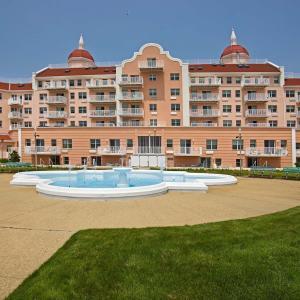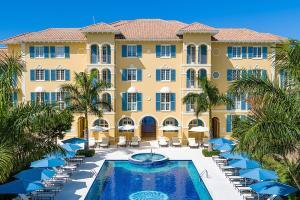Preserving architectural history by restoring old buildings provides cultural, sustainable, and economic benefits to building owners, the community, and future generations. The restoration of old buildings also protects the environment by reusing existing buildings, lessening landfill waste, and reducing the use of natural resources.
Restoring old buildings should aim to protect the property’s historical significance and aesthetics by preserving its original materials. However, components that are damaged beyond repair or do not meet current building codes, safety, and sustainability needs will require upgrading or replacement. In these cases, architects and builders should strive, as much as possible, to maintain the original aesthetics and character of the building.
For example, for old building facade replacement or restoration, Sto’s The A.R.T. of reStore® program provides an innovative solution for restoring old buildings’ facades to their original aesthetics. In addition, our products enhance a structure’s sustainability, safety, and occupant comfort level.
Preserving the Past By Old Building Restoration
The restoration of old buildings provides many cultural, economic, and sustainable benefits to a community; however, achieving these benefits successfully often requires the help of an experienced and qualified historic building restoration expert.
NOTE: Contact Sto Studio for design suggestions to help restore your historic old building with a high-performing, sustainable, aesthetically pleasing, and fully engineered cladding system.
Cultural Benefits of Restoring Old Buildings
Restoration of old buildings helps retain a community’s history, culture, aesthetics, and legacy for the current and future generations.
The National Historic Preservation Act (NHPA)
Nearly fifty years ago, the U.S. Congress recognized the cultural, educational, aesthetic, inspirational, sustainable, and economic importance of restoring old buildings to our country’s heritage by enacting the National Historic Preservation Act (NHPA).
After it passed, the Secretary of the Interior instituted the Standards for the Treatment of Historic Properties to direct the restoration of old buildings in America. Furthermore, National Historic Preservation Fund grant-in-aid projects must follow the Standards for the Treatment of Historic Properties, according to 36 CFR 68.
The Standards provide four approaches to treating historic old building properties: preservation, rehabilitation, restoration, and reconstruction. The treatment depends on the building’s historical significance, proposed use, physical condition, and planned interpretation. All approaches permit code-required work to make the old buildings functional, including upgrading mechanical, plumbing, and electrical systems.
Preservation
Preservation involves applying measures necessary to maintain the existing integrity, materials, and form of a historic, old building. The work includes steps to protect and stabilize the building, and focusing on ongoing maintenance and repairs of historic features and materials rather than extensive replacement and new construction and exterior additions.
Rehabilitation
Rehabilitation involves altering, repairing, and adding to an old building while preserving those features which convey its historical, architectural, or cultural values. Rehabilitation allows for replacing deteriorated parts; however, the replacements must match the original design, color, texture, and materials, if possible.
Restoration
Restoration depicts a property’s character, features, and form from a particular time. To achieve this, builders remove old, deteriorated building components, and replace them with new features that match the original design, color, materials, and texture.
Reconstruction
Reconstruction involves designing and building a new structure to match the building’s appearance from a specific historical time.
Economic Benefits of Restoring Old Buildings
- Encourages local businesses to grow and increases real estate values, which helps the economic viability of historic spaces.
- Allows architects and builders to include energy-efficient, durable building materials in the restoration design of old buildings.
- Rehabilitation often costs less than new construction.
- Existing usable space – faster occupancy.
Sustainable Benefits of Restoration of Old Buildings
Recycling of Building Materials
- Lessens the need for new materials to save natural resources
- Reduces landfill waste and construction, demolition, and hazardous material debris
Energy Savings
- Eliminates the use of energy for demolition and new construction
- Allows for reuse of embodied energy in building materials and systems
- Retrofitting allows for more energy-efficient products, like wall systems, windows, doors, etc.
Sto’s Complete Approach to Old Building Restoration
Sto offers an innovative solution to restoring old building’s facades – The A.R.T. of reStore – aesthetics, repair, and transformation. It offers all the products and services needed to maintain and restore your old building’s facade.
Our product’s engineering will also enhance the building’s sustainability, energy efficiency, safety, and occupant comfort level.
ReStore offers four levels of restoration, from elementary maintenance removing dirt and mold to an entire facade restoration with all of the needed products and support:
- Clean and Recoat: A simple program to remove dirt, mold, and mildew to update and refresh the facade’s color.
- Repair and Refinish: A program to repair small deterioration or damage to EIFS or stucco facades.
- Overclad: A cost-effective program to fix moisture intrusion problems and improve the facade’s energy efficiency and aesthetic appeal.
- Remove and Reclad: New cladding offers a more efficient solution for unrepairable deteriorated exterior walls.
Restoring the Lido Beach Towers, Long Island, NY

Applying StoTherm ci to the 100-year-old Lido Beach Towers facade helped restore the old building to its former glory while also enhancing its sustainability and energy efficiency.
StoTherm ci
StoTherm ci EIFS provides an energy-efficient, high-performance thermal wrap with proven components: continuous insulation, an air-and water resistive barrier, and textured finish options to complete your design.
Sto’s Comprehensive Repair Guide
Sto’s Comprehensive Repair Guide identifies 30 common problems affecting EIFS, masonry, concrete, and stucco with step-by-step illustrated solutions. Click here to download Sto’s Repair Guide.
Endless Aesthetic Choices
Sto provides the aesthetic flexibility to replicate any old building facade, including stone, brick, concrete, and more, with complete design freedom in endless color, material, and texture options.
Sto Studio
Sto Studio offers architectural design assistance to ensure the maximum potential of your old building restoration. We work to create a complete facade concept, including color and material options, to preserve the original character and aesthetics of the property. In addition, we can generate color renderings of your building that will help determine the best facade to maintain the cultural integrity of the building.
Villa Renaissance, Turks and Caicos

System Type: Aesthetics, Coatings
Sto Systems & Products: StoColor® Dryonic™, Stolit® 3.0
Construction Type: Renovation
Building Type: Hospitality
Villa Renaissance’s general manager chose StoColor® Dryonic™ exterior coating with Intelligent Technology + Design to refresh and update the resort’s existing coral facade. The distinctive, cohesive color palette, designed with the assistance of Sto Studio, matched the island’s coral aesthetic and provided the durability and moisture protection to survive its punishing conditions. In addition, they applied Stolit 3.0 on all existing coral renderings.
Restoring Old Buildings for Future Generations with Sto Corp. Products
Old building restoration should preserve the original aesthetics of a structure while repairing and retaining the original building’s features. However, the restoration design should include new equipment and innovative technologies to meet modern codes, ensure occupants’ safety and comfort, and protect the environment through sustainable building materials and methods.
Contact Sto professionals today on how our A.R.T. of reStore™ and Sto Studio can assist you with your old building restorations.


